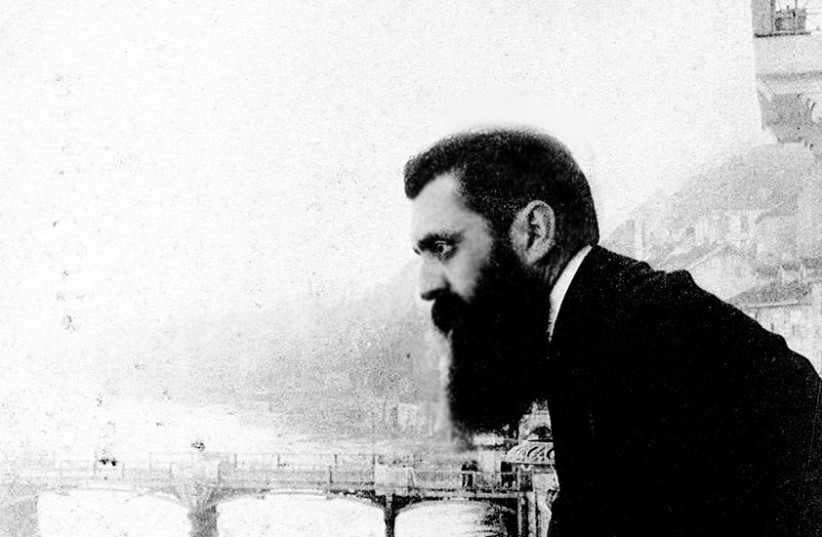On a summer afternoon in 1895, Theodor Herzl and Max Nordau had a beer in a Parisian cafe and engaged in a philosophical debate about what kept Judaism together. They agreed: antisemitism. That is, as Herzl phrased it, “what has made Jews of us.”
But how does this impact the Jews’ pursuit to reclaim their land? On this point, Herzl and Nordau parted ways. Nordau viewed antisemitism as a hurdle to achieving a Jewish state, but Herzl had a different view: “We will be compelled by antisemitism to create the Jewish state.” Herzl’s unique ability to understand the nuanced nature of antisemitism allowed him to extract the asset component from it.
Similarly today, two existential threats to Judaism have hidden assets planted in them. If the right approach is applied, those threats can contribute to Jewish continuity. The existential threat of Israel-bashing forces the disaffiliated Jew back into his Judaism. At Herzl’s time, the rapidly expanding antisemitism movement reminded the disaffiliated Jew who he was. This was true even for those Jews who thought they left Judaism. Herzl wrote about a friend who wante to convert, that “when five thousand like him become baptized, the watchword would simply be changed to Dirty Converts.”
Yet, Herzl took his deep understanding of antisemitism further. He viewed the Jewish realities of his time (Judaism 2.0) as reactionary to European persecution. So dominant were those centuries of persecution – deportations, limits on Jewish professionals, incarceration in Jewish ghettos – that they defined the Jewish nation and hence united it.
Yet, once the Jews would be back home, those pressures that united them would no longer exist, and hence, as Herzl wrote in an 1894 criticism of the play The Wife of Claude, in which the Jews return to their land: “they would discover the very next morning that they long ago ceased to be one people.” Therefore, we need to replace the uniting feature of European persecution that “made Jews of us” with an ideological, political and diplomatic infrastructure of Judaism, and that is Zionism.


As Herzl was getting ready to set this in motion, he understood that just like the Moses-led exodus was not only about immigration from Egypt to Canaan but also about what Herzl called “education through migration,” the Herzl-led exodus would not only be about immigration to Palestine but also – to use our terms – about the transformation of Judaism.
Judaism 3.0 can stop the evaporation of American Jewry
The transformation to Judaism 3.0 can also address another threat to Jewish continuity: the assimilation of American Jewry.
To do that, one needs to understand assimilation in the same depth and nuance that Herzl understood antisemitism: The assimilation of American Jews is not, as it was in 19th-century Europe, assimilation into being a German Protestant or a French Catholic. It is not assimilation into a competing religion nor into another ethnological nation, it is assimilation into Americanism.
Until recently, assimilation to Americanism could have meant the end of being Jewish because it implied shedding one’s Jewish national identity at a time when Jews are no longer religious, but Americanism has evolved. Celebration of one’s ethnological national identity is not just accepted in today’s America but highly encouraged. This is due to societal trends, such as those of heritage identity and embracing multiple identities anchored in the strong uniting trunk of Americanism. Marco Rubio is proud of his Cuban identity and Kamala Harris of her Jamaican and Indian. Similarly, a Jew showcasing his Jewish national identity, Zionism, is a celebration of Americanism.
Moreover, Americanism is an ideology that is intertwined with Zionism. From its beginning, America was about the renewal of the ancient promise: the establishment of a new Jerusalem, the return to a new Zion and rejection of the oppressive dogmas of the European past, as well as a return to God and freedom of worship. From the onset, Americanism was a form of abstract Zionism. When tangible Jewish Zionism began to take shape, it was synergistic with its applied version in America.
Therefore, American Jews assimilating to Americanism is assimilation into a Zionist-friendly ideal. And if one accepts that Zionism is now the anchor of Judaism (Judaism 3.0), such assimilation in turn strengthens the American Jew’s Jewish identity.
Just as US President Joe Biden stated, “You need not be a Jew to be a Zionist.” American Jews should be reassured that you need not be anti-Zionist to be an American. An American Jew is a Zionist as a byproduct of being American.
Judaism 3.0 makes Judaism relevant to the disaffiliated American Jew
Moreover, Judaism 3.0 turns Judaism from an afterthought into a core aspect of the American Jews’ life. The Jew now initiates organic connections to Judaism through Zionism, whether positive or negative.
Recently, Israel-bashing led a group of disaffiliated Jews to do the unthinkable and go to synagogue. There, through deliberations, debates and a lot of engagement, they passed a resolution declaring that their synagogue is anti-Zionist. Indeed, like antisemitism in Herzl’s time, Israel-bashing forced those Jews into their Judaism. Those Jews re-engaged with Judaism through Zionism.
Once back in, such Jews are more likely to engage with other aspects of Judaism, including its religious aspects, and even tikun olam (centering their Jewish identity around the tikun olam state, Israel).
Judaism 3.0 extracts the hidden asset that is embedded in Israel-bashing and assimilation. To do so, we must understand Herzl and his Zionism better.
It took centuries for Jews to understand Moses and develop his Judaism. We are still in the early stages of understanding Herzl. We are still in the early days of Zionism. ■
Herzl to the rescue of Palestinians?
A Catalonian separatist once said that their problem is that Catalonia is occupied by Spain. If Catalonia were occupied by Israel, the world would be pro-Catalonian and nobody would have ever heard of Palestine.
Catalonians should be careful about what they wish for. The pro-Palestinian stance of the world and, in particular, of Europe, led to debilitating consequences for Palestinians.
Europe is the occupier of the Palestinians. It occupies the Palestinian mind, development and true character, and as discussed in this column, it reduces Palestinianism to a single aspect: occupationalism. This creates a dependency not just on Europe but also on conflict perpetuation. The end of the conflict could mean the end of Palestinianism.
Can Palestinians look up to Herzl’s vast understanding of such a European mentality and apply it to their benefit? He wrote, “In the first 25 years of our existence we need, for our development, some rest from Europe, its wars and social complications.”
This is not likely to happen, given the depth of the European occupation of Palestinians and the immense power of the well-funded conflict industry (UN agencies, NGOs, media). To the dismay of Catalonians, Tyroleans, Corsicans, Sumi and other nations in Europe that feel they are under occupation, the world’s attention is likely to stay focused on Palestine and the dogmatic neo-religion of occupationalism.
The writer is the author of the newly released book, Judaism 3.0: Judaism’s Transformation to Zionism (Judaism-Zionism.com).
